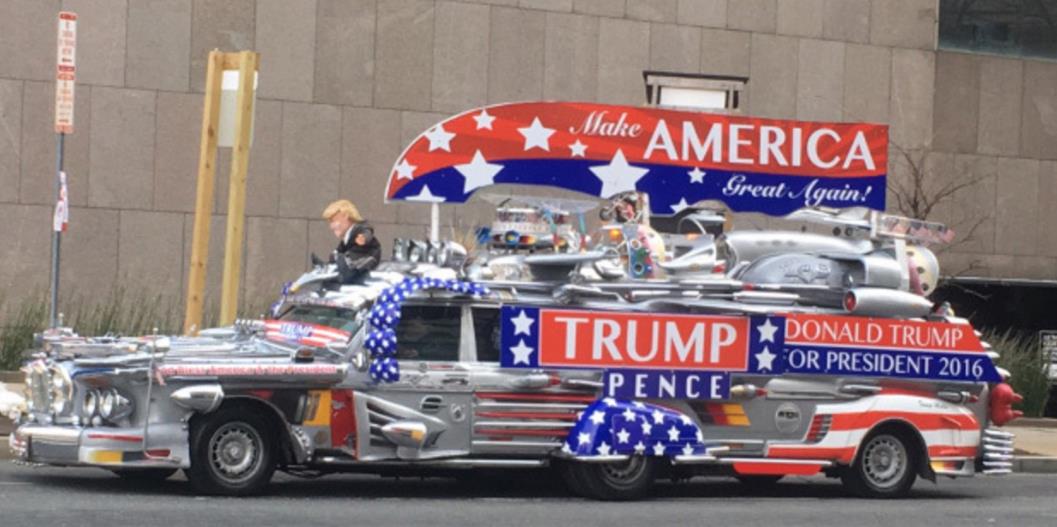Despite Trump: What is and What isn’t—Charlottesville to Boston
Guest Commentary: August Nimtz
 Watching the images from Boston on August 19, and reading the reports I couldn’t help but think about how much has changed in the U.S. despite Trump. In April 1976, a major battle took place there when racist gangs sought to obstruct court-ordered school busing, groups that were far larger in number than any of the crowds who’ve been emboldened by the Trump election. Boston attracted national attention not unlike Charlottesville. But unlike almost all of the present crowds— except for one in Charlottesville whose main perpetrator is now being prosecuted —the ones in Boston, without any prompting from White Supremacists like the KKK, actually pursued bodily harm against Black people, especially the Black students on the buses.
Watching the images from Boston on August 19, and reading the reports I couldn’t help but think about how much has changed in the U.S. despite Trump. In April 1976, a major battle took place there when racist gangs sought to obstruct court-ordered school busing, groups that were far larger in number than any of the crowds who’ve been emboldened by the Trump election. Boston attracted national attention not unlike Charlottesville. But unlike almost all of the present crowds— except for one in Charlottesville whose main perpetrator is now being prosecuted —the ones in Boston, without any prompting from White Supremacists like the KKK, actually pursued bodily harm against Black people, especially the Black students on the buses.
Actor Mark Wahlberg, who grew up in Boston in the immediate aftermath of that period has long apologized for having been seduced by that ethos into actually committing vicious racist acts—evidence of how pervasive the climate was in the city and environs. The iconic image is a bunch of angry racists attacking a Black businessman in a three-piece suit, who had nothing to do with busing, with a long pole to which an American flag was attached. 
It was the perfect propaganda image for those of us who mobilized nationally to defend the Black youth on the buses. We used that photo in all of our advertising for building one of the largest marches in the city’s history. Though not as large as Saturday’s August 19 action, which attracted somewhere between thirty and forty thousand and, thus, dwarfing the fifty to one hundred who stood behind police cordons exercising their right to “free speech,” it was a decisive moment in Boston’s racial politics. It, along with other advances for racial equality in subsequent decades, go a long way in explaining why so many in Boston and environs would come out in such numbers in opposition to what had once been unapologetically displayed on its own streets only a few decades earlier.
To make sure that we could attract the largest number of participants, we not only advertised our march as being a peaceful response to the violent racist gangs but we actually organized ourselves to make sure that our protest remained peaceful. Unbeknownst to me the high school aged daughter of a very influential senior colleague in my department wanted to attend the march. Her parents said she could if, first, she’d be one of the passengers in my car, and, second, that I assure them that she’d be safe. As a still untenured member in the department I had a personal stake in making sure the protest remained peaceful.
The march against the racist forces was organized by a coalition of organizations, one of which was the Socialist Workers Party (SWP) to which I belonged. Not every organization in the coalition was on board with the march being peaceful though the majority voted for that position. Based on prior experience, the SWP organized a contingent in the march to closely monitor any forces who might want to break discipline and physically engage the racists. I was assigned by the party to the contingent. Sure enough, a group of what we call in the movement the ultra-leftists tried to divert the march from the agreed upon course into a confrontation with the racists. Our task was to prevent that from occurring. To do so, we cut the cord of their bull horn once they began employing it, thus, preventing them from doing their confrontational thing. Had violence occurred, triggered by the ultra-leftists, it would have been not only disruptive but could have also endangered people who attended the march believing it would be a peaceful.
In 1980, another tragedy occurred in Greensboro, NC. Four members of the Communist Workers Party (CWP) were brutally murdered (one seriously wounded who I knew) by the KKK after appearing to want to confront the racists with guns. An all-white jury refused to convict the Klan members who committed the murders. Of course, we and other progressive forces denounced the blatant jury nullification though we vehemently disagreed with the CWP’s needless provocation. The idea that a small group of people, however courageous, can beat back entrenched racist and other reactionary forces flies in the face of what history teaches.
 Another example of how much has changed in the U.S. is that of Heather Heyer who was run over by the 20 year-old white supremacist driver, James Alex Fields, in Charlottesville. Heather wasn’t a northern liberal but a young Caucasian woman from Charlottesville, and, without a college degree—as many liberals are so want to point out about Trump supporters. And listening to her mother’s pride about her daughter in her very Virginia working class accent brought home the power of Heather’s example and what it registers; which makes her death all the more tragic.
Another example of how much has changed in the U.S. is that of Heather Heyer who was run over by the 20 year-old white supremacist driver, James Alex Fields, in Charlottesville. Heather wasn’t a northern liberal but a young Caucasian woman from Charlottesville, and, without a college degree—as many liberals are so want to point out about Trump supporters. And listening to her mother’s pride about her daughter in her very Virginia working class accent brought home the power of Heather’s example and what it registers; which makes her death all the more tragic.
Unfortunately, Heather was a member of one of the organizations, the Industrial Workers of the World (IWW), which tend to look for confrontation with the racists and the police. I speak from personal experience when I say this. We had to put IWW members on a short leash when we had our Rodney King demonstration in Minneapolis in 1992 (one of whose key organizers, by the way, before he left the streets for the suites, was the young Keith Ellison, now congressman and Deputy Chair of the Democratic National Committee). They hated the fact that we prevented them from trashing downtown stores as we were marching, 5000-plus strong, in one of the largest demonstrations ever seen in Minneapolis. It is true, we have to admit, that there are indeed individuals and grouplets on the left who do engage in violence and rely on confrontation as their mode of operation. Not only is such conduct dangerous for their own members and those who want to participate in peaceful protests but it also enables agent provocateurs, that is, those on the payroll of the police who seek to discredit progressive movements (such as what happened with the protests against the Republican National Convention when it met in St. Paul in 2008).
Lastly, the most obvious example of the depths of the changes in the U.S.: Who would have believed on November 9, 2016, that more Confederacy monuments would be torn down during a Donald Trump presidency than during any other presidency? I confess that I never expected to see in my lifetime the Robert E. Lee monument in New Orleans removed where I walked and rode by so many times.
As the renowned historian of Reconstruction Eric Foner puts it in his recent NYT essay: “Historical monuments are, among other things, an expression of power—an indication of who has the power to choose how history is remembered in public places.” David Duke and his ilk can’t prevent the removal of the monuments despite all their fawning before Trump. The massive largely proletarian-composed mobilizations of the sixties known as the Civil Rights Movement rendered them impotent. Steven Bannon is right in his characterization of them. “Ethno-nationalism—it’s losers. It’s a fringe element. I think the media plays it up too much, and we gotta help crush it, you know, uh, help crush it more. These guys are a collection of clowns.” And they should never be confused with Trump’s hard core base. Bannon knows who that base is and would never have used such language about them.
The first protest action, by the way, I ever helped to organize, in spring 1964, against the sentencing of Nelson Mandela, took place in front of the White House. Within an hour—I can’t remember exactly—we were greeted with a counter protest by the American Nazi Party and its leader George Lincoln Rockwell. We never felt threatened in any way by their small picket line. As I think about it now, I wonder how they heard we were there. Did someone—I ask almost tongue in cheek—in the Lyndon Johnson White House let them know?
There will indeed be a real fascist movement one day in the U.S.; but only when the ruling class feels threatened by its working class which, we have to admit, is not the case today. It will have to be a situation not unlike what Germany’s ruling class faced in the 1930’s when it decided to ‘send in the clowns’—a totally virulent variety. Until then it’s a serious political mistake to think as some do that fascism is now knocking on the door since November 8, 2016. To do so is to concede unnecessarily to reaction and to ignore the opportunities to do mass work.
I emphasize the glass half full side of the story without in the least ignoring the fact the glass is also half empty. I do because it’s the profound changes I’m highlighting that will be the necessary ingredients in forging the kind of effort to address the half-empty side of the story. It’s not rocket science to recognize that as long as capitalism is in place, there can be no racial equality. Capitalism like all previous class societies is fundamentally incompatible with social equality. And the failure of the struggle for racial equality in its first and second Reconstruction editions is sobering testimony to capitalism’s continuing grip on social reality. I contend that this claim is not unlike what MLK was saying in the last year of his life exactly fifty years ago. I’m referring to his epiphany, in the aftermath of the passage of the Civil Rights Act of 1964 and the Voting Rights Act of 1965, that for there to be racial equality in the U.S. “there would have to be a radical redistribution of economic and political power.” For that to happen there will have to be a mass multi-racial, multi-national, multi-gendered working class movement.
My basic claim is that owing to the profound changes that have taken place in the U.S. over the last half-century, our side, progressive-minded forces, is in a better position today to realize such a goal than we’ve ever been in the entire history of the country. I’m not claiming, of course, that such a mass working class movement in all its skin colors, nationalities and genders is inevitable but only that we’re in a better position today than ever to construct one. The Boston demonstration, the example of Heather Heyer, and the removal of the monuments are simply the most recent evidence of the kinds of opportunities progressive forces have today that have never existed before. And it behooves us to not only recognize but to act on that reality and not merely be passive spectators.
August Nimtz is a professor of political science and African American and African Studies at the University of Minnesota, Minneapolis.




